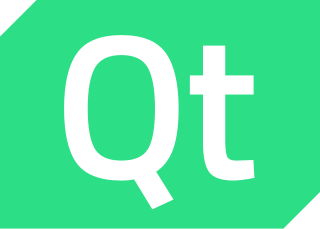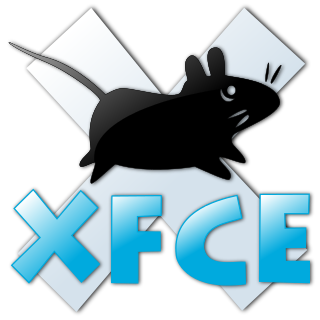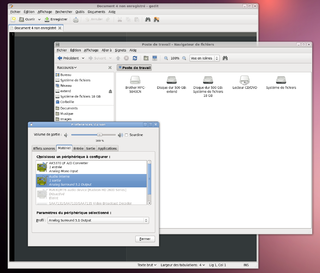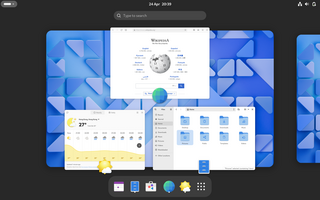
The Common Desktop Environment (CDE) is a desktop environment for Unix and OpenVMS, based on the Motif widget toolkit. It was part of the UNIX 98 Workstation Product Standard, and was for a long time the Unix desktop associated with commercial Unix workstations. It helped to influence early implementations of successor projects such as KDE and GNOME desktop environment, which largely replaced CDE following the turn of the century.

Qt is free and open-source cross-platform software for creating graphical user interfaces as well as cross-platform applications that run on various software and hardware platforms such as Linux, Windows, macOS, Android or embedded systems with little or no change in the underlying codebase while still being a native application with native capabilities and speed.
In computing, a desktop environment (DE) is an implementation of the desktop metaphor made of a bundle of programs running on top of a computer operating system that share a common graphical user interface (GUI), sometimes described as a graphical shell. The desktop environment was seen mostly on personal computers until the rise of mobile computing. Desktop GUIs help the user to easily access and edit files, while they usually do not provide access to all of the features found in the underlying operating system. Instead, the traditional command-line interface (CLI) is still used when full control over the operating system is required.

Xfce or XFCE is a free and open-source desktop environment for Linux and other Unix-like operating systems.

The ROX Desktop is a graphical desktop environment for the X Window System. It is based on the ROX-Filer which is a drag and drop spatial file manager. It is free software released under the GNU General Public License. The environment was inspired by the user interface of RISC OS. The name "ROX" comes from "RISC OS on X". Programs can be installed or removed easily using Zero Install.
freedesktop.org (fd.o) is a project to work on interoperability and shared base technology for free-software desktop environments for the X Window System (X11) and Wayland on Linux and other Unix-like operating systems. It was founded by Havoc Pennington, a GNOME developer working for Red Hat in March 2000. Some of the project's servers are hosted by Portland State University, sponsored by Hewlett-Packard, Intel, and Google.

Bluecurve is a desktop theme for GNOME and KDE created by the Red Hat Artwork project. The main aim of Bluecurve was to create a consistent look throughout the Linux environment, and provide support for various Freedesktop.org desktop standards. It was used in Red Hat Linux in version 8 and 9, and in its successor OS, Fedora Linux through version 4.

PyGTK is a set of Python wrappers for the GTK graphical user interface library. PyGTK is free software and licensed under the LGPL. It is analogous to PyQt/PySide and wxPython, the Python wrappers for Qt and wxWidgets, respectively. Its original author is GNOME developer James Henstridge. There are six people in the core development team, with various other people who have submitted patches and bug reports. PyGTK has been selected as the environment of choice for applications running on One Laptop Per Child systems.

Clearlooks is a theme for GTK, the main widget toolkit used by the GNOME desktop environment. It is based on Red Hat's Bluecurve theme. It was the default theme for GNOME since version 2.12 until GNOME 3 when it was replaced by Adwaita. Many users have contributed themes that have changed the colors and some visual effects, leading to many derivative themes.

Ettore Perazzoli was an Italian free software developer.
A desktop environment is a collection of software designed to give functionality and a certain look and feel to an operating system.

LXDE is a free desktop environment with comparatively low resource requirements. This makes it especially suitable for use on older or resource-constrained personal computers such as netbooks or system on a chip computers.

GTK is a free and open-source cross-platform widget toolkit for creating graphical user interfaces (GUIs). It is licensed under the terms of the GNU Lesser General Public License, allowing both free and proprietary software to use it. It is one of the most popular toolkits for the Wayland and X11 windowing systems.

GNOME, originally an acronym for GNU Network Object Model Environment, is a free and open-source desktop environment for Linux and other Unix-like operating systems.

Cinnamon is a free and open-source desktop environment for Linux and Unix-like operating systems, deriving from GNOME 3 but following traditional desktop metaphor conventions.

GNOME 2 is the second major release of the GNOME desktop environment. Building upon the release of GNOME 1, development of GNOME 2 focused on a greater design-oriented approach that simplified and standardized elements of the environment. It also introduced modern font and image rendering, with improved accessibility and internationalization, and improved performance. It was released on June 26, 2002 at the Linux Symposium.
Client-side decoration (CSD) is the concept of allowing a graphical application software to be responsible for drawing its own window decorations, historically the responsibility of the window manager.

Adwaita is the design language of the GNOME desktop environment. As an implementation, it exists as the default theme and icon set of the GNOME Shell and Phosh, and as widgets for applications targeting usage in GNOME. Adwaita first appeared in 2011 with the release of GNOME 3.0 as a replacement for the design principles used in Clearlooks, and with incremental modernization and refinements, continues with current version releases.















